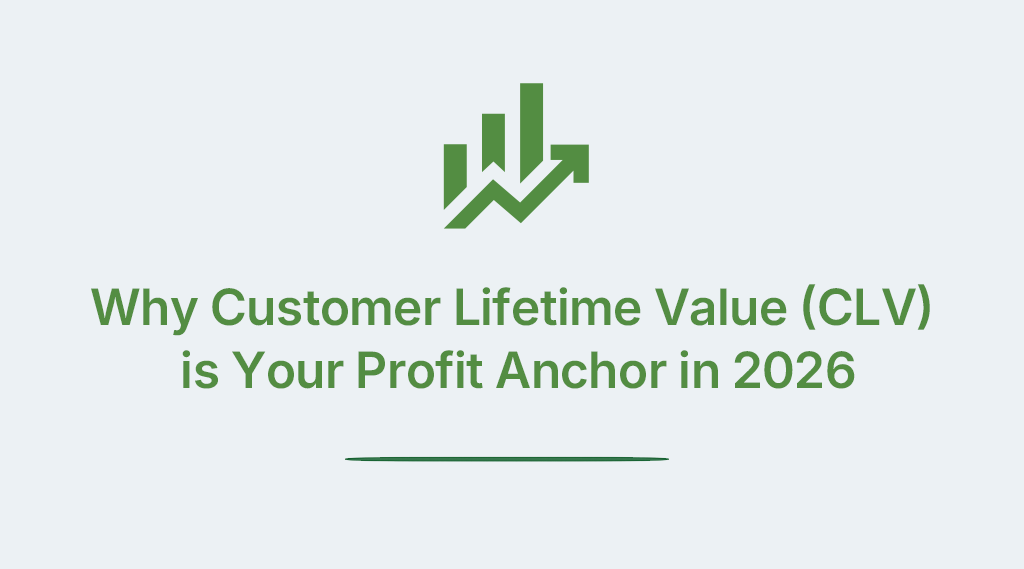For e-commerce and DTC brands, the market in 2025 has settled into a new, challenging reality: Customer Acquisition Cost (CAC) can be unsustainable. The era of raising capital simply to chase high-cost vanity traffic on social media is over. The pressure is intense: marketing leaders are under historic scrutiny from the C-suite to prove the impact of every dollar on genuine financial outcomes.
The question for every retail executive planning for 2026 is this: How do you drive scalable, profitable growth when the old playbook (spend more and more on ads) is financially broken? The answer requires a fundamental pivot away from volume metrics and towards core, long-term indicators like Customer Lifetime Value (CLV).
CLV is a metric that estimates the total value a customer brings to a company over their entire relationship. This value is critical, as your most loyal customers can be worth up to 10x the value of their first purchase, yet 75% of customers only transact once.
Here are the three critical shifts required to thrive in 2026, driven by a CLV-first strategy:
1. The Metric Shift: From Transaction Volume to Long-Term Value
While not the only metric that matters, CLV provides the crucial context for all other KPIs. It factors in purchasing behavior, purchase frequency, average order value, and the length of the customer relationship.
- The Old Rule: Focus media spend on maximizing ROAS in a 30-day window.
- The New Mandate: Structure media spend to acquire customers with the highest LTV potential.
CLV’s Impact on Marketing and Sales:
- Acquisition: CLV helps allocate resources to high CLV acquisition channels and identify high-value customer segments to target. It is also used to suppress low-CLV audiences to prioritize higher-CLV customers.
- Retention: High-CLV customers who are medium-at-risk can be enrolled in targeted retention campaigns using personalized offers. You can also customize cancellation flows based on customer CLV.
- Sales: CLV insights can be utilized to identify cross-selling and upselling opportunities during sales interactions. It also helps forecast revenue potential and guide sales targeting and territory allocation decisions.
2. The Organizational Shift: CLV Across Every Department
Despite popular belief, CLV’s value is not restricted to marketing. CLV insights should be used to inform and support initiatives across all departments. By integrating CLV across the organization, you create a shared definition of the “most valuable customer.”
CLV’s Broader Business Applications:
- Customer Service: Prioritize customer service based on CLV and determine appropriate customer appeasement based on CLV. This allows you to implement proactive strategies for at-risk high-value customers.
- Product: CLV helps identify products and categories that drive high CLV among customers. Product teams can develop new products or enhance existing ones based on preferences observed in high-CLV segments.
- Finance & Corporate Development: CLV helps calculate the ROI of marketing initiatives and potential investments. It is a key metric for raising funds or selling the company, showcasing the financial potential to investors or acquirers.
- Merchandising: Merchandising can allocate inventory storage and availability based on CLV potential to ensure high-CLV customers have access to desired products.
3. The Strategy Shift: Using CLV for Future-Proofing
CLV is more important than ever due to rising costs, digital transformation, and intense competition. When calculated with the right models, CLV can take into account external factors, such as seasonality, that can affect customer behaviors.
- The Old Rule: React to changes in the market after they happen.
- The New Mandate: Use CLV to power predictive analytics that guide strategic decisions.
Why CLV is the Anchor for 2026:
- Budget Clarity: As acquisition, retention, and other customer-related costs rise, CLV helps prioritize where funds will have the most impact.
- Demand Planning: CLV can help reveal potential changes in future customer behaviors to help companies recalibrate their marketing efforts.
- Competitive Edge: It helps uncover what makes high-value customers valuable, so companies can find more like them regardless of what their competition does.
- Efficiency: CLV helps companies make strategic decisions about acquisition, retention, supply chain, product, and merchandising that drive customer-level profitability.
The Profitable Path to 2026
The complexity of the 2026 e-commerce landscape requires a strategic partner focused on leveraging data to maximize CLV. By shifting your focus from short-term transaction volume to long-term customer value, you can build a more resilient and profitable brand.
Ready to transform your e-commerce marketing from an expense center into a profit engine? Book a Discovery Call with Tadpull and let us help you build a profitable growth strategy for 2026.

